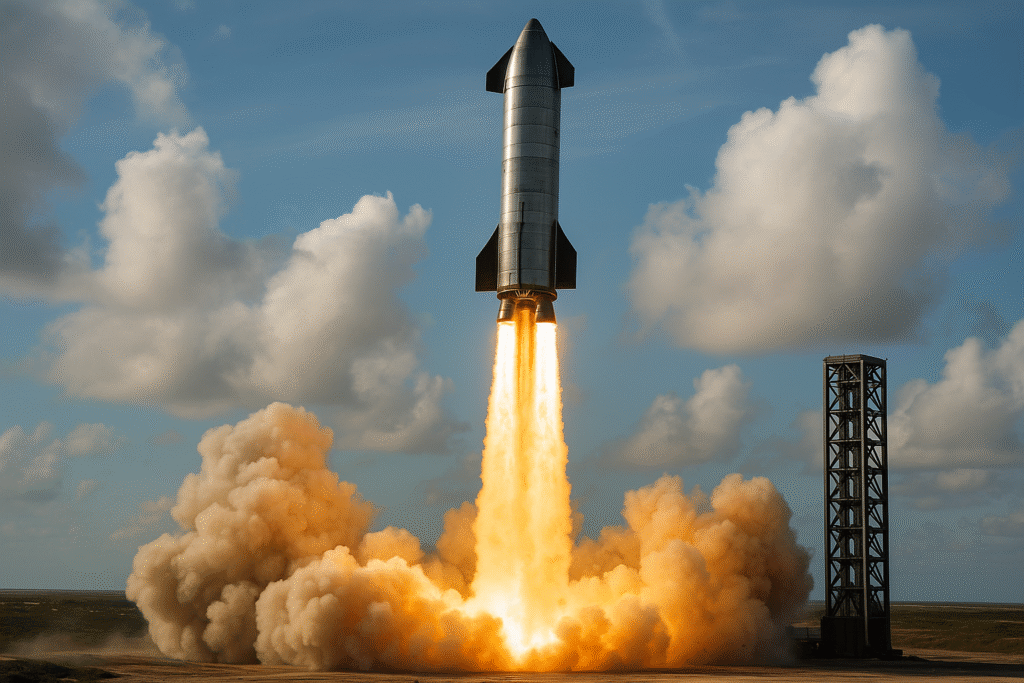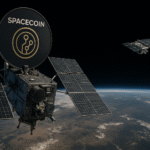By Harshit | 15 October 2025 | Boca Chica, Texas | 1:30 AM EDT
SpaceX has taken a major leap toward interplanetary travel after its Starship rocket successfully completed a full test mission on Tuesday, marking the company’s first major success following three failed launches earlier this year.
“Great work by the SpaceX team!!” wrote CEO Elon Musk on X, celebrating the milestone. The success comes after months of setbacks for the $100 million-per-launch Starship program — the world’s largest and most powerful rocket system.
A Record-Breaking Launch
The two-stage Starship system, consisting of the Super Heavy booster and the Starship spacecraft, lifted off smoothly from SpaceX’s Starbase facility in Boca Chica, Texas. All 33 Raptor engines in the booster ignited successfully, propelling the rocket to the edge of space before the booster separated cleanly and splashed down into the Gulf of Mexico.
The spacecraft continued its climb, reaching nearly 200 kilometers (124 miles) above Earth before coasting in orbit. It then began a controlled re-entry, with onboard sensors capturing valuable data on heat resistance and aerodynamic stability.
While parts of the rocket’s flaps showed signs of burning and oscillation during descent, SpaceX said this was intentional — a stress test to determine the spacecraft’s limits. “This was a great day for SpaceX, executing its full mission for the first time and deploying test satellites along the route,” said Dr. Simeon Barber, a planetary scientist at the Open University.
According to Dr. Barber, SpaceX will have gathered its most complete dataset yet, covering all mission phases: liftoff, orbital cruise, re-entry, and landing. “This is a huge step forward in developing a fully reusable system for future missions to the Moon and Mars,” he said.
From Explosions to Evolution
The road to success has been rocky. Earlier versions of Starship experienced multiple explosions during test flights. In March, a launch failure scattered debris across the Bahamas and Turks and Caicos, grounding operations for months. Another test stand explosion in June raised concerns over safety protocols.
However, the company’s “fail fast, learn fast” philosophy has remained central to its development approach. Each failure generated new engineering data that informed subsequent designs. On Tuesday, SpaceX achieved another technical milestone — successfully executing the “chopstick catch,” a maneuver where the booster was caught midair by mechanical arms upon return to Earth.
The new version of Starship marks a major improvement over its predecessors, integrating upgraded heat shields, reinforced flaps, and enhanced flight control software.
NASA’s Artemis Program on the Line
The success of Starship holds major implications for NASA’s Artemis program, which aims to return humans to the Moon for the first time since 1972. NASA has contracted SpaceX to modify Starship into a lunar lander for the Artemis III mission, currently targeted for 2027.
“This is a big step forward for NASA’s Artemis program, but there’s still a lot of development work ahead to make Starship human-rated,” Dr. Barber said. “The hardware must be proven safe and reliable before astronauts can board.”
Despite this progress, many experts doubt NASA will meet its 2027 timeline. Dr. Ken Kremer, research scientist and founder of Space UpClose, remarked, “The US reaching the Moon by 2027 is extremely unlikely. I wouldn’t say impossible, but it’s very unlikely.”
Elon Musk’s Broader Vision
Musk has repeatedly stated that Starship will eventually make humanity a multi-planetary species. The company plans to conduct uncrewed missions to Mars within the next 12 months and achieve human certification by late 2026.
The billionaire entrepreneur, who has invested billions into Starship development, said the goal is to build a fully reusable, mass-transit system capable of carrying up to 100 people to the Moon, Mars, and beyond. “The ultimate goal is to make life multiplanetary,” Musk has said in past interviews.
However, the program has faced scrutiny not only for its engineering challenges but also for Musk’s political distractions. His involvement in U.S. politics, particularly his brief alliance and later fallout with former President Donald Trump, had raised concerns that his focus on space innovation was wavering.
The Global Race to the Moon
Starship’s progress also plays into an intensifying space race between the United States and China. Beijing’s lunar program, Chang’e, aims to land humans on the Moon by 2030, and some analysts believe China may achieve that milestone before NASA’s Artemis.
“The race is on,” said Dr. Kremer. “Even with Starship’s progress, China’s methodical and state-backed approach may allow it to reach the lunar surface first.”
A Step Forward, Not the Finish Line
Tuesday’s mission ended with Starship returning to Earth battered but largely intact — a sign of resilience and engineering triumph. It was not a flawless flight, but for SpaceX, it proved the system’s potential for reusability and long-duration missions.
“This success gets the program back on track,” Dr. Kremer said. “Getting to the Moon, however, remains another question entirely.”







